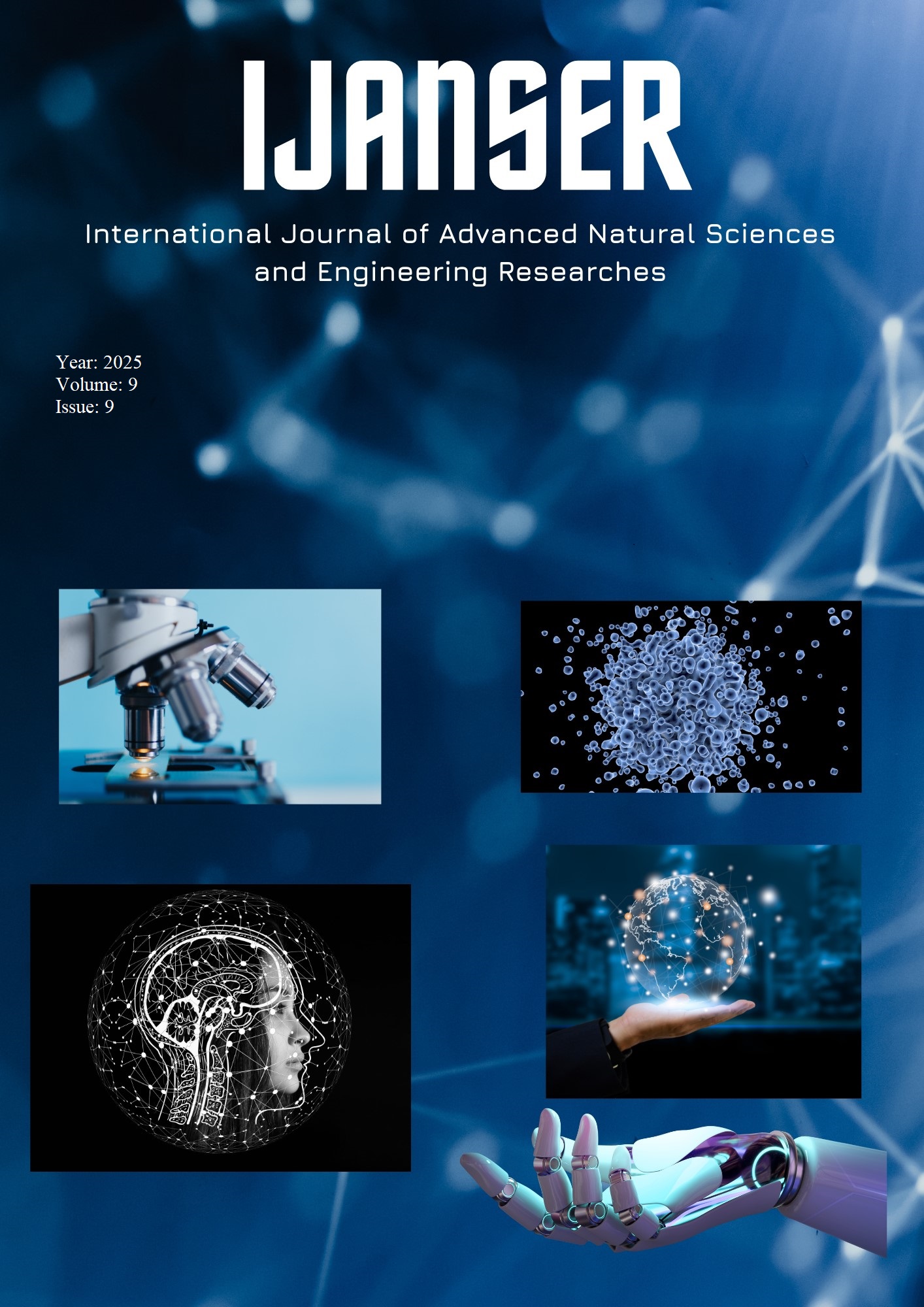Comparative Assessment of Chromatographic Methods in the Analysis of Industrial Air Pollutants: Technological Developments and Application Strategies of the Last Decade
Keywords:
Industrial air pollution, emissions, chromatographic methods, gas chromatography, high-performance liquid chromatographyAbstract
Industrial activities are indispensable to the economic and technological progress of modern
societies; however, they simultaneously generate considerable risks to environmental quality and human
health due to the release of atmospheric pollutants. Emissions from power plants, chemical processes,
metallurgical operations, petrochemical industries, and waste incineration facilities comprise a broad
spectrum of contaminants, including volatile organic compounds, polycyclic aromatic hydrocarbons,
pesticide residues, and heavy metal derivatives. These pollutants are well-documented for their toxic,
mutagenic, and carcinogenic effects, posing direct threats to public health while also causing persistent
disruptions in ecosystem dynamics. Accordingly, the accurate and reliable determination of such
substances, even at trace concentrations, is vital for the effective enforcement of environmental regulations
and the development of sustainable public health strategies.
Over the last decade, chromatographic techniques have become central to the monitoring and quantification
of industrial air pollutants. Gas chromatography (GC) and high-performance liquid chromatography
(HPLC) are widely employed for the analysis of volatile and semi-volatile organic compounds. Parallel
advancements in sampling techniques (e.g., passive and active sampling, thermal desorption,
microextraction approaches) and detector technologies (e.g., MS/MS, FLD, FID) have markedly improved
analytical sensitivity, precision, and environmental sustainability.
This review aims to provide a systematic overview of recent progress in chromatographic methods for
industrial air pollution monitoring, critically evaluate current applications, and identify emerging research
opportunities for future developments.
Downloads
References
Çukurluoğlu, S., & Besim, T. (2015). Fuel Origin Emission Inventory of Denizli Organized Industrial District. Pamukkale Üniversitesi Mühendislik Bilimleri Dergisi, 21(6), 248-253.
Demirel, H., & Ateş, A. (2018). Sapanca Gölü çevresinde karayolu trafiğinden kaynaklanan hava kirleticilerinin emisyon envanteri. Sakarya University Journal of Science, 22(2), 150-158.
Toros, H., & Bağış, S. (2017). Hava kirlilik modellerinde kullanılacak emisyon envanteri oluşturulması için yaklaşımlar ve İstanbul hava kirliliği dağılımı örneği. Çukurova Üniversitesi Mühendislik-Mimarlık Fakültesi Dergisi, 32(2), 1-12.
Özel, H., Cihan, P., Özcan, H. K., Aydin, S., & Hanedar, A. (2021). Hava Kirletici Parametrelerinin Hava Kalitesi İndeksine Uzun Zamanlı Etkilerinin İncelenmesi: Çerkezköy Organize Sanayi Bölgesi Örneği. Kırklareli Üniversitesi Mühendislik ve Fen Bilimleri Dergisi, 7(1), 94-106.
Dube, S. (2023). Reducing air pollution through smart energy management in industrial clusters of India. Environmental Progress & Sustainable Energy, 42(4), e14169.
Ashmeet Singh, 1Harsshit Goenka, 1Prakhar Sahu, 1Venkatesh L.,2Dr. Sindhu Sree M., 3Dr. Pavithra G., 4Dr. T.C.Manjunath (2023) Design & development of a air pollution monitoring using smartphone. International Journal of Engineering Technology and Management Sciences, Issue: 3 Volume No.7
Tang DeLiang, T. D., Wang CuiCui, W. C., Nie JieSheng, N. J., Chen RenJie, C. R., Niu Qiao, N. Q., Kan HaiDong, K. H., ... & Perera, F. (2014). Health benefits of improving air quality in Taiyuan, China.
Gertsiuk, M. (2022). Chromatography in Ukraine: Development and Achievements. Separations, 9(5), 114.
Tunç, D. Ç., Dündar, E., İpek, E. A., Toros, H., & Ulubey, A. (2022). Evaluation of Air Quality in Eskisehir. Journal of Research in Atmospheric Science, 4(2), 36-40.
Ulanova, T. S., Nurislamova, T. V., Popova, N. A., & Mal'tseva, O. A. (2020). Working out a procedure for determining potentially hazardous volatile organic compounds (trichloroethylene and tetrachloroethylene) in ambient air. Health Risk Analysis, (4), 113-120.
Çetin, M., & Demirci, O. K. (2016). Erzincan’da doğal gaz kullanımının hava kalitesine etkisi. Erzincan University Journal of Science and Technology, 9(1), 8-18.
Kalıpcı, E., & Başer, V. (2019). Coğrafi Bilgi Sistemi (CBS) ve hava kalitesi verileri kullanılarak Türkiye’nin hava kirliliğinin değerlendirilmesi. Karadeniz Fen Bilimleri Dergisi, 9(2), 377-389.
Li, X., Tolefe, E. C., Healy, R. M., Dorman, F. L., Kleywegt, S., Simpson, A. J., ... & Jobst, K. J. (2025). Exposing Halogenated Airborne Pollutants by Non-Targeted Screening of Passive Samplers Using Ion Mobility-Mass Spectrometry. Environmental Science & Technology, 59(21), 10390-10399.
Moura, P. C., & Vassilenko, V. (2022). Gas Chromatography–Ion Mobility Spectrometry as a tool for quick detection of hazardous volatile organic compounds in indoor and ambient air: A university campus case study. European Journal of Mass Spectrometry, 28(5-6), 113-126.
Ratnaningsih, W., Prayogo, W., Hidayahtullah, M. C., Azizah, R. N., Shabrina, H. M., & Fitria, L. (2024). Aır Qualıty Monıtorıng In Footwear Industrıal Areas Usıng Taıwan Aır Qualıty Monıtorıng Network (Taqmn) In Taıpeı Cıty. Berkala Penelitian Teknologi Kulit, Sepatu, dan Produk Kulit, 23(2), 227-238.
Baur, T., Amann, J., Schultealbert, C., & Schütze, A. (2021). Field study of metal oxide semiconductor gas sensors in temperature cycled operation for selective VOC monitoring in indoor air. Atmosphere, 12(5), 647.
Siregar, N. D., Situmorang, M., & Humaidi, S.(2024). Monitoring and Analyzing Air Quality in Several Locations around Medan City Using IoT-Based Integrated Sensors. International Journal of Current Science Research and Review, 7 (6),4301-4314.
Wang, G., Jia, S., Niu, X., Liu, Y., Tian, H., Chen, X., & Shi, G. (2018). Detection of peroxyl radicals from polluted air by free radical reaction combined with liquid chromatography signal amplification technique. Journal of Separation Science, 41(9), 1930-1937.
Sitasuwan, P., Powers, T. W., Medwid, T., Huang, Y., Bare, B., & Lee, L. A. (2021). Enhancing the multi-attribute method through an automated and high-throughput sample preparation. In MAbs ,Taylor & Francis, (13,1).
Ghosh, M., Chatterjee, P. N., Pradhan, M. K., & Salony, K. (2022). Assessment of Ambient Air quality in Industrial Cluster at Paradip (India) based on Air Quality Index (AQI). Eco. Env. & Cons. 28 (August Suppl. Issue): 2022; p104-S109
Evans, A. R., Hebert, A. S., Mulholland, J., Lewis, M. J., & Hu, P. (2021). ID–MAM: a validated identity and multi-attribute monitoring method for commercial release and stability testing of a bispecific antibody. Analytical Chemistry, 93(26), 9166-9173.
Kamboj, K., Sisodiya, S., Mathur, A. K., Zare, A., & Verma, P. (2022). Assessment and spatial distribution mapping of criteria pollutants. Water, Air, & Soil Pollution, 233(3), 82.
Liu, P., Zhu, X., Wu, W., Ludwig, R., Song, H., Li, R., ... & Leone, A. M. (2019). Subunit mass analysis for monitoring multiple attributes of monoclonal antibodies. Rapid Communications in Mass Spectrometry, 33(1), 31-40.





